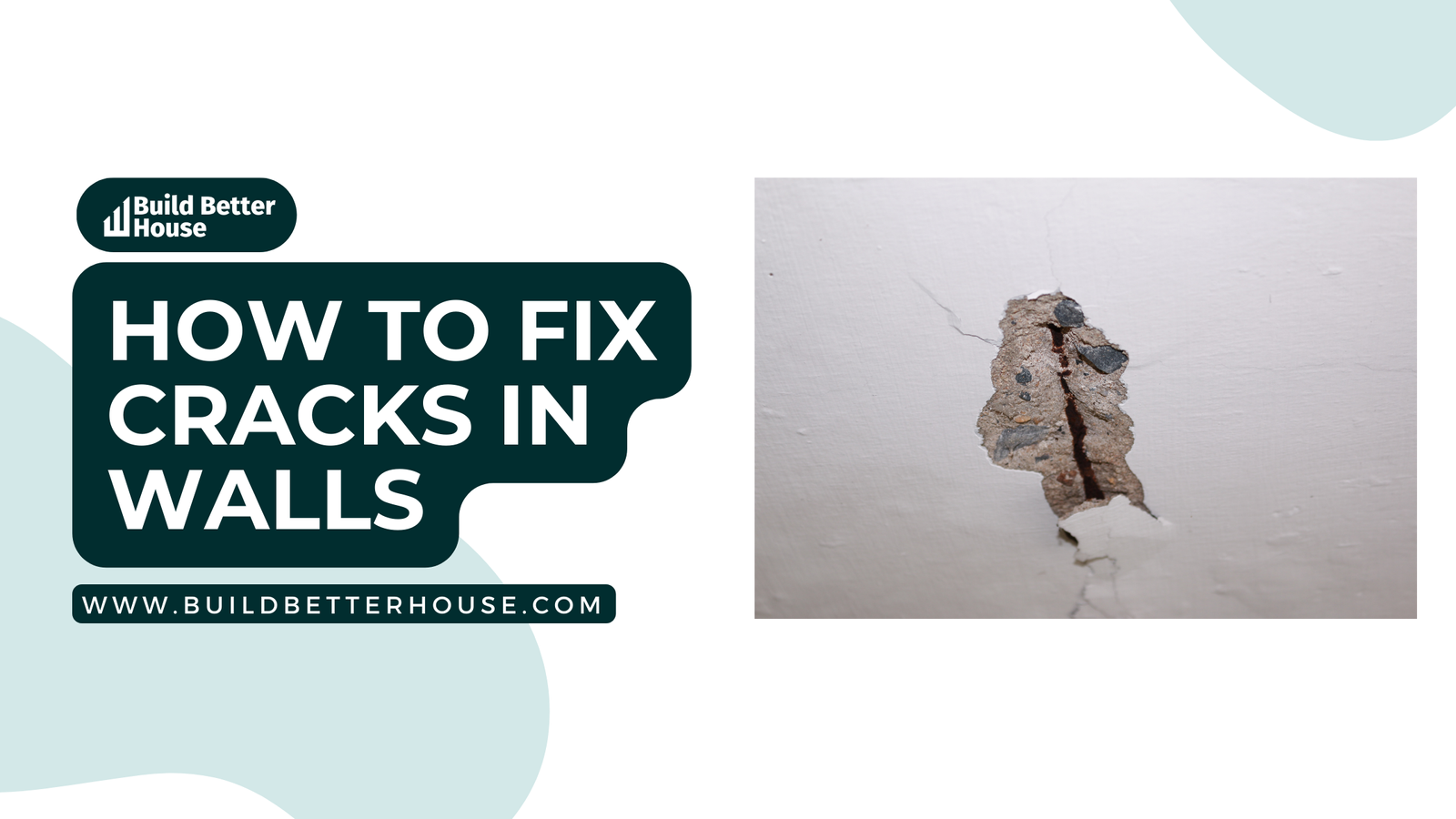How to Fix Cracks in Walls: Simple Expert Techniques

Cracks in walls can be a common sight in many homes, but they don’t have to be a permanent fixture. Learning how to fix these imperfections can not only improve the appearance of your living space but also help you address any potential underlying issues. In this article, we will discuss the process of repairing cracks in various types of walls and offer tips for preventing future cracks from forming.

Identifying the cause and type of crack is an essential first step in the repair process. Once you’ve determined the cause, you can begin preparing the necessary materials and tools to begin wall repair. Fixing hairline cracks in drywall, repairing cracks in plaster walls, and addressing structural issues require different approaches, so knowing your specific situation is crucial. Proper sealing, patching, and finishing techniques will ensure that your wall repair is both smooth and lasting.
Key Takeaways
- Determine the cause and type of crack in your wall to choose the appropriate repair method.
- Gather necessary materials and tools for wall repair based on your specific situation.
- Follow proper techniques for sealing, patching, and finishing the repair to ensure a smooth and lasting result.
Identifying the Causes of Cracks in Walls
Cracks in walls may be caused by a variety of factors. Understanding the underlying reasons is crucial for determining the appropriate repair method. By identifying the cause of the cracks, you can target the root of the problem and prevent future occurrences.
One common cause of wall cracks is structural problems with the foundation. When the building settles unevenly, it can distort the structure and create cracks. Look for signs, such as uneven floors or misaligned doors and windows, that indicate foundation issues.
Water damage is another potential cause of wall cracks. Leaking pipes, poor drainage around the home, or even simply high humidity levels can result in weakened or damaged walls. Inspect areas near plumbing fixtures, such as bathrooms and kitchens, as well as basements or crawl spaces, for signs of water damage.
Termite damage can also lead to cracks in walls. Termites typically target wood structures, but their activity can cause damage to plaster or drywall, as well. Look for signs of infestations, like mud tubes or discarded wings, and consult with a pest control professional if you suspect termite damage.
Climate control plays a significant role in the formation of wall cracks, as well. Rapid temperature fluctuations or high humidity levels can cause materials within the wall to contract and expand. This constant movement puts stress on the structure, eventually leading to cracks. Consider installing a dehumidifier or air conditioning system to maintain a more consistent indoor environment.
In summary, when you identify cracks in your walls, examine the potential causes, such as foundation issues, water damage, termite infestations, or climate-related factors. Armed with this knowledge, you can then take appropriate steps to correct the problem and ensure the longevity of your home.
Assessing the Type of Cracks
When you notice cracks in your walls, it’s essential to determine the type of crack before taking any repair steps. The different types of cracks – such as hairline cracks, diagonal cracks, and vertical cracks – each have unique characteristics and may indicate different underlying issues.
Hairline cracks are very thin and barely visible. They generally occur due to normal settling or slight movement in a building. You don’t need to worry too much about these cracks, as they can typically be fixed with a simple paint job or some light patching.
Diagonal cracks appear at an angle and can be wider than hairline cracks. These cracks may indicate differential settling or underlying structural problems. It’s essential to monitor these cracks and consult a professional if you see any significant widening or lengthening over time.
Vertical cracks run straight up and down the wall and may signal foundation issues. If the crack is wider than 1/8 inch, it could be a sign of a more serious problem and warrants further investigation from a structural engineer. However, if the crack is relatively small and not widening over time, a simple repair method, such as using a patching compound, should suffice.
In conclusion, when you encounter cracks in your walls, the first step is to assess the type of crack and understand its potential implications. Act accordingly by either monitoring the crack, executing a simple repair, or consulting a professional for more severe cases. Always remember to maintain a confident, knowledgeable, neutral, and clear tone while addressing these issues.
Preparing for Wall Repair
Before starting the wall repair, gather all the necessary tools and materials. You will need the following:
- Sandpaper
- Adhesive
- Putty knife
- Vacuum or brush
- Clean cloth or damp cloth
Begin by inspecting the cracked area. Remove any loose plaster or debris using the putty knife. Be careful not to apply too much pressure, as you don’t want to cause further damage to the wall.
Next, clean the area thoroughly. This step is crucial to ensure the adhesive and filler materials adhere properly to the wall. Use a vacuum or brush to remove dust and debris from the crack. If needed, you may also use a damp cloth to wipe the area clean. It’s essential to let the wall dry completely before moving on to the next step.
After the wall is clean, prepare the adhesive for use. Some adhesives may require mixing, while others are ready-to-use. Follow the manufacturer’s instructions for the specific adhesive you’ve chosen. It’s important to choose the right adhesive for your specific wall type, whether it’s drywall, plaster, or concrete.
Lastly, gather your putty knife, sandpaper, and any other necessary tools so they are immediately at hand. This will streamline the repair process and save you time while working on the wall. Having everything ready to go will ensure a successful and efficient wall repair process.
Fixing Hairline Cracks
Hairline cracks in walls may seem minor, but they can be a sign of a larger issue or may worsen over time. With the right tools and techniques, you can repair these cracks and prevent further damage. Here’s a step-by-step guide to fixing hairline cracks in your walls.
- Clean the area: Start by cleaning the drywall area around the hairline crack. Remove any loose bits of plaster, spackle, and any grit. If you see old drywall tape, textures, or popped nail heads, remove those as well.
- Apply mesh tape: To bridge the crack and prevent it from reappearing, apply a self-adhesive mesh tape over the crack. Make sure the tape extends at least an inch beyond the crack on both ends. This will reinforce the area and provide a stronger foundation for the joint compound.
- Apply joint compound: Mix joint compound according to the manufacturer’s instructions and apply it over the mesh tape using a drywall knife. Spread the compound evenly, feathering the edges outward to smoothly blend it with the surrounding wall. Allow the compound to dry fully, which may take around 24 hours, depending on the product used.
- Sand the area: Once the compound is completely dry, lightly sand it with fine-grit sandpaper to create a smooth surface. Be gentle to avoid damaging the mesh tape or surrounding drywall.
- Apply a second layer of joint compound: If needed, apply a second layer of joint compound to fill any remaining imperfections and create an even surface. Remember to feather the edges again for a seamless transition between the patched area and the existing wall. Allow the compound to dry completely before proceeding.
- Final sanding and painting: When the joint compound is fully dry, sand the area once more with fine-grit sandpaper to seamlessly blend the patch. Wipe off any dust with a damp cloth, and then you can paint the area to match the rest of your wall.
By following these steps, you can confidently and effectively repair hairline cracks in your walls, ensuring a smooth finish and preventing further damage.
Repairing Cracks in Drywall
Repairing cracks in drywall can seem daunting, but with the right tools and techniques, you can easily fix those pesky blemishes. Before starting your repair project, gather the necessary supplies, such as a utility knife, joint compound, putty knife, paper tape (paper drywall tape is preferred), and a sanding sponge or sandpaper.
First, inspect the crack and use your utility knife to enlarge it slightly, removing any loose material in and around the crack. This will help the joint compound adhere better to the surface. After enlarging the crack, clean the area to ensure there’s no dust or debris present.
Next, apply a thin layer of joint compound to the crack using a putty knife. Make sure to completely fill the crack and smooth out the compound. It’s essential to start with a thin layer because thick layers may cause additional cracks as the compound dries.
Now, it’s time to use the paper tape. Cut a piece of paper drywall tape slightly longer than the crack, and press it into the wet joint compound. This will help to reinforce the repair and prevent the crack from reappearing. Smooth out the tape with your putty knife, ensuring there are no wrinkles or bubbles present.
Allow the joint compound to dry for the recommended time on the product label (typically 24 hours). After it dries, apply another thin layer of joint compound over the paper tape, aiming for a smooth finish. Extend the compound about two inches beyond the edges of the tape and feather the edges to blend it into the wall.
Once the second layer of joint compound is dry, inspect your drywall repair for any imperfections. If needed, apply additional thin layers of joint compound until you achieve a smooth surface. Sand the area gently with a sanding sponge or fine-grit sandpaper to achieve a seamless finish.
Your drywall repair is now complete. With the right tools and techniques, repairing cracks in drywall is a simple and efficient process. Remember to remain confident and knowledgeable as you tackle your next home improvement project.
Addressing Cracks in Plaster Walls
Before you begin to fix cracks in your plaster walls, it’s essential to identify the causes, which can include excessive rainfall and flooding, periods of drought, poor and shallow foundations, or nearby tree root systems. By understanding the causes, you can take preventative measures to avoid future cracks.
To repair cracks in plaster walls, follow these steps:
- Prepare the area: Clear any loose plaster or debris from the crack using a utility knife or a scraper.
- Widen the crack: Use the utility knife or a chisel to create a v-notch by slightly widening the crack. This will help the joint compound adhere better and create a smoother surface while repairing. Be careful not to damage the surrounding plaster.
- Clean the crack: Ensure the crack is free of dust and debris by brushing it with a clean, dry paintbrush, or vacuuming it with a brush attachment.
- Apply joint compound: Using a putty knife, spread a layer of joint compound over the crack, pressing it firmly into the v-notched area. Be sure to smooth the compound and feather its edges to blend it seamlessly with the surrounding plaster.
- Add drywall tape: For spider or narrow cracks, apply self-adhesive drywall tape over the joint compound. To ensure a superior bond, firmly press the tape with your putty knife. This step helps reinforce the repaired area and prevents the crack from reappearing.
- Sand and paint: Once the joint compound has dried completely, use fine-grit sandpaper to sand the area smoothly. Afterward, prime and paint the repaired section to match the rest of the wall.
By following these steps, you can effectively address cracks in your plaster walls and restore the appearance of your home’s interior. Remember always to prioritize safety and use appropriate tools when working on your walls.
Dealing with Structural Issues
When dealing with structural issues, it is essential to first identify the root cause of the problem. Some common contributors to structural issues in your home may include overgrown trees, cracked drains, leaking rainwater goods, or missing roof tiles.
If you notice any cracks in your walls, it’s crucial to address them as soon as possible. For minor cracks, you can simply use elastomeric caulk to seal them. However, for more severe cracks, it is best to consult a structural engineer to assess the underlying cause of the problem and provide expert guidance on fixing it.
Keep an eye on the functionality of your doors and windows as they can be indicators of underlying structural issues. Difficulty in opening and closing doors or windows might indicate foundation problems or uneven settling of the house. In such cases, it is best to get professional help to address the root cause of the issue.
Inspect your home for any signs of water leaks, as they can exacerbate structural problems. Leaks can be caused by issues such as cracked pipes, ill-fitting roof components, or damaged window seals. It is crucial to identify and fix these issues promptly to prevent further damage to your home’s structure.
In summary, here’s what you need to remember when dealing with structural issues:
- Identify the root cause of the problem
- Seal minor cracks with elastomeric caulk
- Consult a structural engineer for severe cracks and foundation issues
- Monitor doors and windows for functionality and alignment
- Identify and repair water leaks to prevent further damage Remember to only use the information provided by the search results if it is relevant and accurate. Do not plagiarize any of the content.
Sealing and Patching the Cracks
Before you begin fixing wall cracks, ensure you have a putty knife, chisel, cement, concrete, drywall compound, and patching material handy. These tools and materials are essential for the repair process.
First, use a chisel to gently enlarge the crack, providing a better surface for the patching material to adhere to. Remove any debris or loose materials with a brush or vacuum cleaner. This step is essential for a proper bond between the patching material and the wall.
Next, prepare the patching material. If you are repairing cracks in concrete or masonry walls, mix the cement and concrete thoroughly, ensuring a consistent texture. For drywall, use a premixed drywall compound or mix the compound with water according to the manufacturer’s instructions.
Apply the patching material using a putty knife. For masonry and concrete walls, press the cement and concrete mixture firmly into the crack using a trowel, ensuring full coverage. For drywall, spread the compound evenly over the crack, slightly extending beyond the edges. This will allow you to feather the compound onto the wall for a smooth surface.
Allow the patching material to dry according to the manufacturer’s recommended drying time. For larger cracks or deeper repairs in masonry walls, it may be necessary to apply multiple layers of patching material. Each layer should be left to dry before adding the next one.
Once the patching material is fully dry, sand the surface using a medium-grit sandpaper to create a smooth, even finish. Be careful not to remove too much material, as this could create a depression in the wall.
Finally, apply a primer to the repaired area so that it matches the surrounding wall when painted. After the primer dries, paint the area to match the rest of the wall. With these steps, you should successfully seal and patch wall cracks, leaving your walls looking good as new.
Finishing the Wall Repair
Once the repair material has dried and cured, it’s time to finish the wall repair. Start by sanding the repaired area using a sanding block with fine sandpaper. This will help remove any excess material, and ensure a smooth surface. Make sure to apply even pressure, and sand in a circular motion to avoid creating any uneven spots.
After sanding, it’s essential to wipe down the area with a damp cloth to remove any dust or debris before painting. At this stage, it’s crucial to inspect the wall repair carefully for any imperfections. If there are any visible cracks or uneven areas, you may need to apply a second coat of repair material and repeat the sanding process.
Once you’re satisfied with the smoothness of the wall repair, it’s time to paint. Start by applying a primer over the repaired area to ensure proper paint adhesion. Allow the primer to dry according to the manufacturer’s instructions, and then apply a coat of your chosen paint color. When using a paintbrush, utilize long, even strokes for consistent coverage. If you’re using a paint roller, always roll in a “W” pattern to ensure even application.
It’s important to note that you may need to apply additional coats of paint to achieve a seamless blend with the surrounding wall color. After the paint has dried completely, take a step back and examine the wall repair. With a confident, knowledgeable, and clear approach, you’ve successfully repaired the crack in your wall, ensuring a smooth and properly finished surface.
Painting and Final Touches
Once you have successfully repaired the cracks in your walls, it’s time to apply a fresh coat of paint and add the final touches. By following these steps, you can achieve a seamless paint job that leaves no traces of discoloration or cracks.
Before you begin painting, make sure the repaired area is completely dry and smooth. If you have used a filler or cement to fix the cracks, give it ample time to set and dry. You may also want to lightly sand the surface to ensure a smooth finish. This is especially important for poured concrete walls, where an even surface is crucial.
Next, choose the right type of paint for your wall. Remember that using a high-quality, durable paint can minimize the risk of future discoloration or peeling. Match the paint color to the existing wall as closely as possible, and if necessary, consider adjusting the entire wall color to create a cohesive appearance.
Once you have your paint ready, thoroughly clean the surface using a damp cloth or sponge to remove any dust or debris that might interfere with the final result. You should also clean the surrounding areas to avoid blending in any dirt or contaminants with the new paint.
To apply the paint, use a high-quality paintbrush or roller in a smooth, continuous motion, ensuring that you cover the entire repair in an even and consistent manner. For poured concrete walls, you may want to use a masonry brush or roller to help achieve a smooth finish. Start with a thin layer and allow it to dry before applying a second coat, if needed.
After your paint job is complete and allowed time to dry, take a step back and look for any imperfections. If you notice any spots where the paint appears uneven, gently sand the area and apply another coat of paint, taking care to blend it with the surrounding wall.
By following these steps and using a confident, knowledgeable, neutral, and clear approach, you can successfully complete the painting and final touches of your wall repair, achieving a polished and seamless look that brings harmony back to your space.
Preventing Future Cracks
Maintaining proper climate control plays a significant role in preventing cracks in your walls. By regulating the humidity and temperature within your home, you can minimize the stress and pressure on your walls, which can help prevent cracks from forming.
Ensure that you have a well-functioning HVAC system for both heating and cooling purposes. Make it a priority to schedule regular maintenance and service checks for your HVAC system, and replace filters as needed to ensure efficient air circulation. Investing in a quality dehumidifier or humidifier can further help you maintain an ideal indoor humidity level, which is typically between 30% to 50%.
Additionally, keeping your home properly insulated can help maintain a stable temperature, thus reducing stress on the walls. When insulating your walls and ceilings, utilize proper materials that are suitable for your climate, as well as following local building codes.
Another critical step in preventing future cracks is to prioritize the exterior maintenance of your home. Water damage and improper drainage can cause cracks, so be sure to keep your gutters clean, fix any leaking pipes, and maintain the grading around your home to direct water away from the foundation.
Keep an eye on the structural integrity of your home by regularly checking the foundation and walls for signs of damage, deterioration, or new cracks. Address any issues as soon as you spot them to prevent them from becoming more severe.
By following these measures, you can confidently ensure that the likelihood of future cracks appearing in your walls will be minimized, and your home can remain a secure and comfortable living environment.
Frequently Asked Questions
What is the best method for repairing drywall cracks?
To repair drywall cracks, you can use joint compound or spackle. Apply a thin layer of the material with a putty knife, let it dry, then sand it smooth. Repeat the process until the crack is fully covered and the surface is even.
How can I conceal cracks in walls effectively?
To effectively conceal wall cracks, you can use paintable caulk or textured paint, which can help blend the repaired area with the rest of the wall. Sand the repaired area smooth, prime it, and then apply the paint or caulk for a seamless finish.
What materials are required for fixing cracks in brick walls?
Fixing cracks in brick walls typically requires a masonry crack filler or mortar mix, a putty knife or trowel, a wire brush, and sandpaper. For larger cracks, you may need to replace damaged bricks and repoint the mortar joints.
Are there any DIY solutions for repairing drywall ceiling cracks?
Yes, DIY solutions for repairing drywall ceiling cracks involve using a joint compound or spackle, along with a flexible putty knife to apply the material, sanding block, and sandpaper. Carefully apply the material to the crack, let it dry and sand it smooth. Repeat as needed.
How do I determine if a wall crack indicates foundation issues?
Wall cracks could indicate foundation issues if they are horizontal, widening, or accompanied by other signs such as sticking doors or windows, uneven floors, or misaligned trim. If you suspect foundation problems, it’s best to consult a professional for evaluation.
Can cracks in drywall seams and corners be easily fixed?
Yes, cracks in drywall seams and corners can be fixed by re-taping the joint. Remove the old tape and apply a new layer of joint compound with a putty knife. Press a new strip of drywall tape into the joint compound, cover it with another layer of compound, let it dry, and then sand it smooth. Apply additional layers of compound if needed for a seamless finish.






